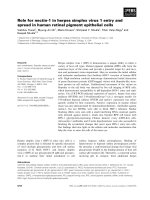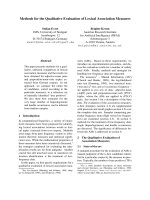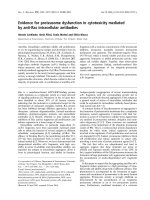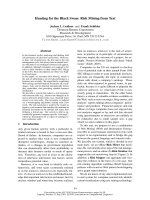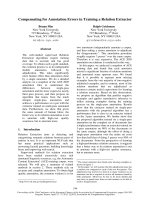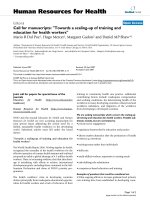Báo cáo sinh học: "Guidelines for gene nomenclature in ruminants 1991 E Andresen" doc
Bạn đang xem bản rút gọn của tài liệu. Xem và tải ngay bản đầy đủ của tài liệu tại đây (255.75 KB, 6 trang )
Letter
to
the
Editor
Guidelines
for
gene
nomenclature
in
ruminants
1991
E
Andresen
T
Broad
2
L
Di
Stasio
3
CHS
Dolling
4
D
Hill
5
K
Huston
B
Larsen
7
JJ
Lauvergne
8
H
Levéziel
9
X
Malher
1
P
Millar
AL
Rae
C
Renieri
EM
Tucker
1
Department
of
Animal
Science
and
Animal
Health,
Division
of
Animal
Genetics,
Bülowsvej
13,
DK
1870
Frederiksberg
C,
Denmark;
2
DSIR
Grasslands,
Palmerston
North,
New
Zealand;
3
Department
of
Animal
Science,
Via
Genova
6,
10126
Turin,
Italy;
4
Box
74,
McLaren
Vale,
SA
5171,
Australia;
5
Department
of
Biochemistry,
University
of
Otago,
Box
56,
Dunedin,
New
Zealand;
6
1689
Arthur
Dr,
Wooster,
OH
44691,
USA;
7
National
Institute
of
Animal
Science,
Department
of
Animal
Physiology
and
Biochemistry,
PO
Box
39,
DK
8830
Tjele,
Denmark;
8
Department
of Animal
Genetics,
Factorial
Genetics,
INRA
CRJ,
78352
Jouy-en-Josas
Cedex,
France;
9
Department
of
Animal
Genetics,
Biochemical
Genetics,
INRA
CRJ,
78352
Jouy-en-Josas
Cedex,
France;
10
Animal
Production,
National
Veterinary
School,
CP
3013,
44
087
Nantes
Cedex
03,
France;
11
Britbreed
Ltd,
12A
Riselaw
Cr,
Edinburgh
10,
UK;
12
16,
Wallace
Place,
Palmerston
North,
New
Zealand;
13
Institute
of
Animal
Production,
Faculty of
Veterinary
Medicine,
Via
San
Costanzo
4,
06
100
Perugia,
Italy;
14
AFRC,
Institute
of
Animal
Physiology
and
Genetics
Research,
Baraham,
Cambridge
CB2
4AT,
UK
(Received
22
July
1991;
accepted
7
August
1991)
Summary -
The
set
of
proposed
guidelines
for
gene
nomenclature
in
sheep
(Ovis
aries
L)
and
goats
(Ca
P
ra
hircus
L)
which
had
been
drawn
up
during
the
1987
COGNOSAG
Workshop
at
Gontard/Manosque,
France,
was
revised
by
committees
during
the
1988
and
1989
COGNOSAG
Workshops
at
Gontard/Manosque,
France,
and
Eugene,
Oregon,
USA.
This
set
has
been
revised
in
July
1991,
at
a
workshop
at
Gontard/Manosque,
France,
to
accommodate
all
ruminants
and
to
facilitate
the
development
of
a
comparative
genome
nomenclature.
cattle
/
goat
/
sheep
/
gene
nomenclature
Résumé -
Nomenclature
des
gènes
des
ruminants
1991.
Les
directives
pour
la
nomen-
clature
des
gènes
du
mouton
(Ovis
aries
L)
et
de
la
chèvre
(Capra
hircus
L)
élaborées
au
cours
de
l’Atelier
du
COGOVICA
tenu
à
Gontard/Manosque
en
juillet
1987
ont
été
révisées
lors
des
Ateliers
du
COGOVICA
de
juillet
1988
(Manosque)
et
de
juin
1989
(Eu-
gene,
Orégon,
Etats-Unis).
Ces
directives
ont
été
revues
en
juillet
1991
au
cours
d’un
Atelier
du
COGOVICA
organisé
à
GontardlManosque
en
juillet
1991,
de
manière
à
être
applicables
à
tous
les
ruminants
et
afin
de faciliter
les
progrès
de
la
nomenclature
comparée
de
leur
génome.
bovin
/
chèvre
/
ovin
/
nomenclature
génétique
INTRODUCTION
The
guidelines
from
the
present
workshop
are
based
on
earlier
proposals
from
COGNOSAG
Workshop
at
Gontard/Manosque,
July
1986
(Lauvergne
and
Searle,
1988),
Manosque,
July
1987
(Alexieva
et
al,
1989),
Gontard/Manosque,
July
1988
and
Eugene,
June
1989
(Alexieva
et
al,
1990).
The
guidelines
have
been
enlarged
to
include
all
ruminants
and
comparative
genome
nomenclature.
LOCUS
The
locus
name
Choice
of
name
The
name
in
English
should
be
brief
and
either
convey
as
accurately
as
possible
the
character
affected
by
alleles
segregating
at
the
locus
or
reflect
the
effect
or
function
by
which
the
locus
is
recognized.
The
name
may
indicate
a
morphological
or
disease
character
(ear
length,
for
example),
a
body
system
or
body
function,
or
a
biochemical
property
or
nucleotide
sequence.
Should
several
body
parts
be
affected
by
an
allele,
the
locus
would
be
named
after
the
part
in
which
expression
occurs
most
frequently.
As
far
as
possible,
the
principle
of
interspecific
homology
will
be
applied
to
loci
detected
by
biochemical,
serological,
or
nucleotide
methods
as
well
as
to
loci
with
visible
effects.
The
use
of
single
letters
as
names
for
loci
or
alleles
will
be
avoided
in
the
future.
For
purposes
of
alphabetic
listing,
all
Greek
symbols
used
in
the
past
should
be
replaced
by
Latin
letters,
and
placed
after
the
name.
Example
Haemoglobin
becomes
Haemoglobin
Beta.
If
a
newly
described
locus
has
the
same
or
similar
effect
to
one
already
named,
but
no
proof
of
their
identity
has
been
obtained,
then
it
may
be
named
in
English
according
to
the
breed,
location,
or
population
of
origin.
Printing
the
name
The
locus
name
will
be
in
Latin
characters
or
a
combination
of
Latin
characters
and
Arabic
numerals.
The
use
of
italics
is
optional.
In
order
to
distinguish
the
locus
name
from
an
allele
which
may
be
identically
written,
the
initial
letter
of
the
locus
name
will
be
capitalised.
If
the
locus
name
is
of
2
or
3
words,
each
word
will
begin
with
a
capital latin
character.
Examples :
Agouti;
Ear
Length;
Fecundity
Java,
Haemoglobin
Beta.
Agouti,
Ear
Length;
Fecundity
Java;
Haemoglobin
Beta.
The
locus
symbol
Choice
of
the
symbol
For
newly
reported
loci,
special
care
should
be
exercised
in
selecting
an
appropriate
symbol
to
avoid
duplication
and
confusion
with
existing
nomenclature.
Every
effort
should
be
made
to
ensure
that
the
symbols
selected
should
conform
to
those
in
current
usage
for
homologous
loci.
The
locus
symbol
will
consist
of
1
to
5
italicised
Latin
letters
or
a
combination
of
letters
and
Arabic
numerals.
The
initial
character
will
always
be
a
capital
Latin
character
which,
if
possible,
will
be
the
initial
letter
of
the
name
of
the
locus
to
facilitate
alphabetical
listing.
For
loci
other
than
those
for
coat
colour
and
visible
traits,
upper
case
Latin
letters
only,
or
upper
case
letters
combined
with
Arabic
numerals
must
be
used.
If
the
locus
name
is
of
2
or
3
words,
and
the
initial
letters
are
used
in
the
locus
symbol,
then
these
letters
will
be
in
Latin
capitals.
All
characters
in
a
locus
symbol
should
be
written
on
the
same
line;
no
superscripts
or
subscripts;
no
Roman
numerals
or
Greek
letters
may
be
used.
Where
appropriate,
the
symbol
should
indicate
the
biochemical
property
or
nucleotide
sequence.
The
rules
of
mammalian
interspecific
homology
already
used
in
the
choice
of
the
name
of
the
locus
will
be
applied
to
the
choice
of
the
symbol.
The
designation
of
prefixes
denoting
mammalian
species
of
origin
was
considered
but
no
formal
proposals
for
these
are
made
here.
Printing
the
symbol
The
locus
symbol
will
be
in
italics
if
possible
or
underlined
if
not
in
italics.
Locus
symbols
need
not
be
italicised
in
data
bases.
Example :
the
symbol
of
the
Agouti
locus :
A
or
A.
ALLELES
Allele name
Choice
of
the
name
Alleles,
particularly
for
coat
colour
and
visible
traits,
should
be
given
brief
names
chosen
to
convey
as
accurately
as
possible
the
variation
caused
by
the
allele.
Alleles
at
other
loci
if
not
given
names
must
be
given
symbols
as
described
in
the
Allele
symbol
section.
Printing
the
name
The
allele
name
will
be
in
italics,
or
underlined
if
not
in
italics.
In
order
to
distinguish
the
allele
name
from
the
locus
name
which
in
some.
cases
may
be
the
same,
the
initial
letter
of
the
allele
name
will
always
be
lower
case.
This
does
not
apply
when
a
symbol
is
used
instead
of
an
allele
name.
Examples :
the
allele
for
polled
condition
at
the
Horns
locus :
polled
or
polled,
an
allele
at
the
Haemoglobin
Beta
locus :
B
or
B.
-
Allele
synbol
Choice
of
symbol
The
allele
symbol
will
consist
of
a
maximum
of
4
characters
(Latin
letters
or
Arabic
numerals).
As
far
as
possible
the
allele
symbol
will
be
an
abbreviation
of
the
allele
name
and
start
with
the
same
letter.
In
the
loci
detected
by
biochemical,
serological
or
nucleotide
methods,
the
allele
name
and
symbol
may
be
identical.
Greek
letters
and
Roman
numerals
must
not
be
used.
The
symbol
+
can
be
used
alone
for
identification
of
the
standard
allele
(&dquo;wild
type&dquo;)
for
alleles
having
visible
effects.
Neither
+
nor -
symbols
may
be
used
in
the
alleles
detected
by
biochemical,
serological
or
nucleotide
methods.
Alleles
known
to
be
recessive
should
have
lower
case
letters
only.
All
other
alleles
should
have
an
upper
case
initial
letter
with
the
rest
being
lower
case.
Internationally
accepted
designations
for
cell
surface
antigens,
including
erythro-
cyte
and
lymphocyte
antigens,
are
not
at
present
included
in
these
guidelines.
Printing
the
symbol
The
allele
symbol
is
always
written
with
the
locus
symbol
and
may
be
written
as
a
superscript
following
the
locus
symbol
or
an
asterisk
may
be
introduced
between
the
locus
and
allele
symbols.
The
allele
symbol
should
be
printed
adjacent
to
the
locus
symbol.
The
allele
symbol
will
be
in
italics
if
possible
and
underlined
if
not
in
italics.
Allele
symbols
need
not
be
italicised
in
data
bases.
Examples :
the
recessive
allele
laornless
at
the
Horns
locus
in
sheep
will
be
printed :
in
italics,
Hold
or
Ho
*
hl
underlined,
Hohl
or
Ho * hl.
The
dominant
allele
polled
will
have
the
symbol :
in
italics,
Ho
p
or Ho * P
underlined,
Ho
p
or
Ho * P.
GENOTYPE
TERMINOLOGY
-
The
genotype
of
an
individual
should
be
shown
by
printing
the
relevant
locus
and
allelic
symbols
for
the
2
homologous
chromosomes
concerned,
separated
by
a
slash,
eg,
Ho
p
/Ho
P
or
Hop
/H
o’.
-
Unlinked
loci
should
be
separated
by
semicolons.
-
Linked
or
syntenic
loci
should
be
separated
by
a
space
and
listed
in
alphabetical
order
when
gene
order
and
phase
are
not
known.
-
For
X-linl.:ed
traits,
the
hemizygous
case
should
be
designated
by
/Y
from
the
locus
and
allele
symbol,
eg,
FecX
*
I/Y.
-
The
1’-linl:ed
traits
should
be
designated
by
/X
from
the
locus
and
allele
symbol.
PHENOTYPE
TERMINOLOGY
The
phenotype
symbol
should
have
the
same
characters
as
genotypic
and
allelic
symbols.
The
difference
is
that
the
characters
will
not
be
underlined
or
in
italics
and
will
be
written
adjacent
to
each
other
but
without
any
asterisk.
Square
brackets
[
]
may
also
be
used
in
phenotypic
terminology.
!1
space
should
separate
locus
characters
and
allele
characters,
eg
the
genotype
Ho
P
/Ho
+
is
equivalent
to
phenotype
Ho
P.
RECOMMENDATION
COGNOSAG
recommends
that
these
guidelines
should
be
used
in
the
naming
of
loci
and
alleles
discovered
in
the
future.
REFERENCES
Alcxicva
S A,
Denis
B,
Dolling
CHS,
Lauvergne
JJ,
Lundie
RS,
Millar
P,
Rae
AL,
Renieri
C,
Sponenberg
DP,
Tucker
ER>1
(1989)
Gene
nomenclature
in
sheep
and
goats
1987.
In:
Standardized
Genetic
Nomenclature
for
Sheep
and
Goats
1987.
COGNOSAD
Workshop
198
(Lauvergne
JJ
ed)
Bureau
des
Ressources
G6n6tiques,
Paris,
France,
17-21
Alesieva
SA,
Aliev
GA,
Bourzat
D,
Denis
B,
Dolling
CHS,
Lauvergne
JJ,
Lundie
RS,
rvlalher
X,
Millar
P,
Rachkovsky
IVIL,
Rae
AL,
Renieri
C,
Sponenberg
DP,
Tucker
EM
(1990)
Gene
nomenclature
in
sheep
and
goats
1989.
In:
Loci
for
Coat
Colour
of
Slaeep
and
Goats
1989.
COGNOSAG
Worshops
1988
and
1989
(Lauvergne
JJ,
ed)
COGOVICA/COGNOSAG,
Clamart,
France,
3-7
Lauvergne
JJ,
Searle
AG
(1988)
Proposed
rules
for
genic
nomenclature
in
sheep
and
goats.
In:
Standardized
Genetic
Nomenclature
for
Sheep
and
Goats
1986.
COG-
NOSAG
Workshop
1986
(Lauvergne
JJ,
ed)
Bureau
des
Ressources
G6n6tiqiies,
Paris,
France,
107-110
